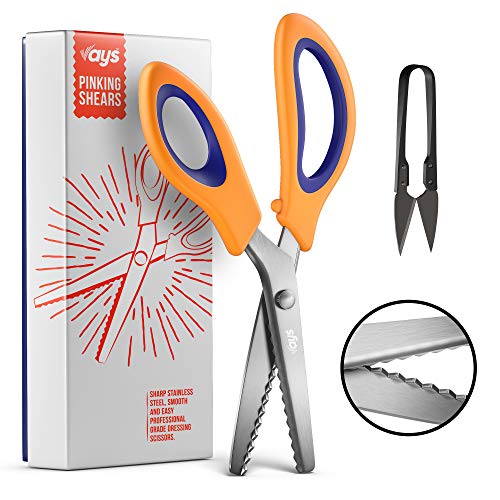Pinking scissors: the solution to fraying fabric?
When it comes to sewing, one of the most frustrating things that can happen is fraying fabric. A single loose thread can ruin an entire project, causing you to spend extra time and effort fixing the issue. Many sewers and crafters have turned to pinking scissors as a preventative measure to avoid fraying. But do pinking scissors really prevent fabric from fraying? Let’s take a closer look.
What are pinking scissors?
Pinking scissors are specialized scissors with serrated or zigzag blades. The blades create a saw-tooth edge on fabric, which helps to reduce fraying. These scissors can be used on a variety of fabrics, including woven, knitted, and felted materials. Pinking scissors are commonly used in sewing, quilting, and crafting projects to finish seams and edges.
How do pinking scissors work?
The zigzag or serrated blades of pinking scissors help to prevent fraying by limiting the movement of the fabric’s threads. When fabric is cut with pinking scissors, the saw-tooth edge creates small notches along the cut edge. These notches disrupt the straight lines of the fabric’s threads, making it more difficult for them to unravel and fray.
While pinking scissors can help to reduce fraying, it is important to note that they are not foolproof. Fabric with a loose weave or delicate fibers may still fray, even when cut with pinking scissors. Additionally, pinking scissors are not suitable for all types of fabric. Knitted fabrics and stretchy materials, for example, may not benefit from pinking shears as much as woven fabrics.
Alternatives to pinking scissors
If you find that pinking scissors are not effectively preventing fraying on certain fabrics, there are alternative methods you can try. One popular option is using a serger or overlock machine to finish raw edges. These machines create a finished edge by trimming excess fabric and encasing the remaining threads in a stitch. This method is especially useful for fabrics that are prone to fraying, such as lightweight cotton and chiffon.
Another option is using a fabric sealant or fray check product. These liquid solutions can be applied to the cut edge of fabric to secure the threads and prevent fraying. Fabric sealants typically dry clear and flexible, making them a discreet and durable solution. However, it is important to test the fabric sealant on a small, inconspicuous area before applying it to the entire fabric piece, as it may alter the color or texture of the fabric.
Tips for preventing fraying
In addition to using pinking scissors or alternative methods, there are several other tips and techniques you can utilize to prevent fabric from fraying:
- Use a smaller stitch length when sewing seams, as this creates more secure stitches that are less likely to unravel.
- Consider using a fabric stabilizer or interfacing to reinforce fabric before cutting and sewing.
- Apply a line of stitching or decorative trim along the edge of the fabric to both prevent fraying and add visual interest to the finished project.
- Always prewash and dry your fabric before cutting and sewing to minimize shrinkage and fraying.
- Consider using a rotary cutter and cutting mat to achieve clean, straight edges that are less likely to fray.
Ultimately, the effectiveness of pinking scissors in preventing fabric from fraying will depend on the type of fabric being used and the individual sewing techniques employed. While pinking scissors can be a helpful tool in reducing fraying, it is important to experiment with different methods and find the one that works best for your specific project and fabric. Remember, prevention is key when it comes to avoiding fraying and ensuring your sewing projects withstand the test of time.






